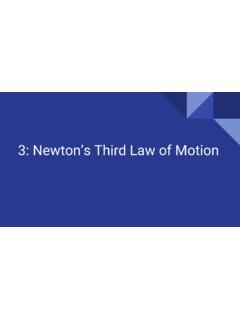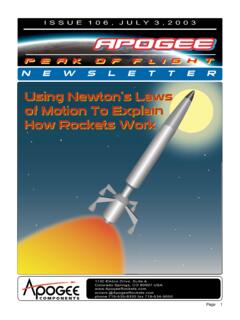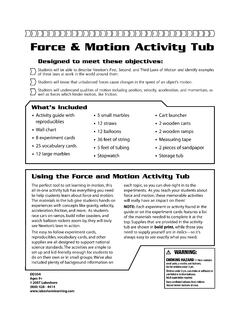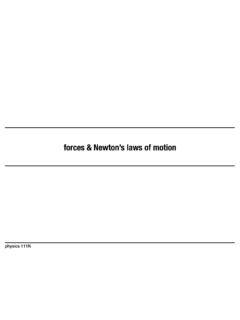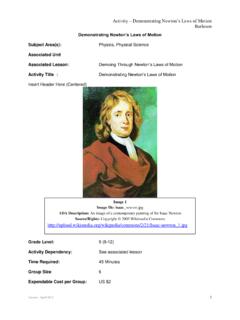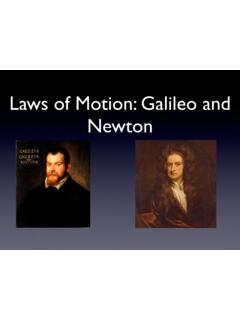Transcription of Newton's First Law of Motion
1 newton s First Law of Motion Educator Notes Learning Objectives Students predict and make observations about the nature of forces and Motion . Safety Hot glue guns are required for this activity. Students should never touch the hot components of a hot glue gun. Instruct students to notify the teacher immediately should a student burn themselves. Introduce the Challenge Have students quietly read the background information or read it out loud to the class and have students follow along. The background information can be found on the student worksheet. Facilitate the Challenge Ask Start this activity by asking students the following questions related to what they experience while inside of a vehicle. What happens to the passengers and cargo inside of a vehicle if it is originally moving at a constant speed, but then abruptly comes to a stop? What happens to the passengers and cargo inside of a vehicle if it is initially at rest, but then abruptly accelerates forward?
2 Cars have brakes to stop the vehicle s Motion , but why are seatbelts and airbags necessary for passenger safety? Teacher-led Demonstration Place an action figure on top of a physics cart or toy car. This demonstration will work best on a flat, hard surface. From a resting position, accelerate the car forward and have students observe what happens to the action figure. Ask students if this demonstration supports their hypothesis from the previous inquiry discussion questions. Set the cart with the action figure moving at a constant forward speed and then bring the cart to an abrupt stop. Once again, have students observe what happens to the action figure. Ask students if this demonstration supports their hypothesis from the previous inquiry discussion questions. Grades 6 to 12 Suggested Pacing 60 minutes total Read and discuss background - 10 min Watch newton s First Law STEM onstration video - 5 min Hovercraft activity and student observations - 30 min Student lab questions - 10 min Post-activity question discussion - 5 min Materials newton s First Law Student Worksheet Physics cart or toy car Action figure Hovercraft supplies and instructions which can be found at Next Generation Science Standards MS-PS2-2 N e x t G e n S T E M 1 newton s First Law of Motion 2 N e x t G e n S T E M STEM onstration Video Watch the video STEM onstrations: newton s First Law at After the video, ask students to briefly discuss the similarities and differences between what they experience in a vehicle on Earth and what the astronauts aboard the space station experience during a reboost.
3 Create Place students in groups of three or four to help each other assemble a hovercraft. It may take an extra pair of hands to attach the inflated balloon onto the nozzle. Have each student build their own hovercraft by following the instructions found at Give students plenty of time to build a hovercraft and instruct them to write down their observations for each situation in the data table that can be found on their student worksheet. Test Allow students time to test their hovercraft, guided by the Student Observations section of the Student Worksheet. Share Ask students to share some of their responses to question number four on the Student Worksheet. Discuss answers and then guide students toward the similarities and differences between their hovercraft and the international space station in terms of newton s First Law of Motion . More to Explore For more lesson plans and activities associated with newton s Laws, visit Christa McAuliffe s Lost Lessons at Name: _____ newton s First Law Student Worksheet Student Background newton s First Law plays a fascinating role on the International Space Station.
4 If an astronaut needs to pass a tool to their crewmate, they simply need to apply a force to it. According to newton s First Law, the tool will float at the same velocity until the other crew member grabs it! Objects in Motion stay in Motion and objects at rest stay at rest until acted upon by a net external force. A change in an object s Motion depends on the net external force or sum of the forces acting on the object, and the mass of the object. On the station, objects in Motion will keep moving at a constant velocity until they impact a wall or another object. newton s First Law of Motion is often called the Law of Inertia. Inertia is the property of matter in which objects can resist a change in Motion . How does this example translate to life in space? The space station is orbiting at approximately 17,500 mph around Earth. The astronauts inside are traveling at the same speed as the space station.
5 What would happen to the crew or any object that is not strapped down if the station s thruster, or small engines outside the station, began to slowly accelerate the station forward? A reboost is the process of using thrusters to increase the altitude of the space station to keep it moving along its orbital path, approximately 250 miles above Earth. Whenever the space station needs a reboost, a visiting spacecraft can dock and use its thrusters to keep the station going on its orbital path. Why does the station need an occasional reboost from these thrusters? After all, Isaac newton taught us that everything in Motion tends to stay in Motion , so why is a reboost necessary? Just like a rolling ball slows to a stop due to friction created between it and the ground, the station also experiences friction between it and particles from Earth s atmosphere. Friction is defined as the resistive force an object encounters when moving past another surface.
6 The station is just on the edge of Earth s upper atmosphere, where few air molecules produce small amounts of friction and resist the Motion of the space station. The frictional force is opposite to t he direction that the station is travelling. If left unchecked, the space station s orbit would slowly change, and the space station would fall toward Earth and burn up in our atmosphere. Do not fear, however! NASA makes sure that the space station and crew are safe at all times and provides regular reboosts to keep the crew safely in orbit around Earth. Activity Using the supplies given to you by your teacher, build a hovercraft by following the instructions at Once your hovercraft is successfully built, proceed to the Student Observations section, test out each situation, and make observations on the Motion of your hovercraft. N e x t G e n S T E M 1 newton s First Law of Motion 2 N e x t G e n S T E M Student Observations Pump up your balloon and release the hovercraft.
7 Pump up your balloon and release the hovercraft. Describe what happens to the hovercraft when it runs into another object like a wall or another hovercraft. Pump up your balloon and release the hovercraft. While in Motion , push the hovercraft in a different direction. Pump up your balloon and release the hovercraft. What happens to the hovercraft when the balloon runs out of air? Student Observations Post-Activity Questions 1. When the balloon runs out of air, a net external force causes the hovercraft to come to rest. What is the name of the force causing the hovercraft to slow to a stop? 2. Set your hovercraft in Motion . Once it is in Motion , push the hovercraft so that it begins moving in a different direction. How has the Motion of the hovercraft changed according to newton s First Law? Explain. 3. What improvement can you make to your hovercraft to make it hover longer or move further using the materials available to you?
8 If you have time, try it out! 4. Write down some similarities and differences between your hovercraft and the International Space Station. Be prepared to share your group s ideas with the class. Similarities: Differences.










